Analysis of water quality parameters in selected areas of palakkad district
K. Parimala Gandhi1 *
DOI: http://dx.doi.org/10.12944/CWE.3.2.28
Due to pressure of human activity, urbanization and industrialization, the ground water sources are degraded gradually; therefore pure, safe, healthy and odorless drinking water is a matter in deep concern. There are many pollutants in ground water due to sewage viz., organic and inorganic pollutants, heavy metals, pesticides, fluoride etc; the purpose was to ascertain the quality of water from these sources. Samples were taken from 25 sampling points and analyzed for pH, EC, TDS, TH, F-, Ca, Mg, Cl-, D.O, and Alkalinity using standard techniques in laboratory (APHA 1985)1. The data showed the variation of the investigated parameters in samples as follows pH: 6.8-8, EC: 233.4-3426 µmhos/cm, TDS: 113.6-981.5 mg/L, Alkalinity: 70-477.5mg/L, D.O:2.4-24.8mg/L, Mg-H: 2.92-33.21 mg/L, Ca-H: 26.4-313.6mg/L, TH: 82.8-1210mg/L, Cl- : 40-1265 mg/L, F- : 0.4-2.65 ppm. The result revealed that the quality of drinking water of Chittur is very poor which can be used for drinking and cooking only after prior treatment.
Copy the following to cite this article:
Gandhi K.S. Analysis of water quality parameters in selected areas of palakkad district. Curr World Environ 2008;3(2):283-287 DOI:http://dx.doi.org/10.12944/CWE.3.2.28
Copy the following to cite this URL:
Gandhi K.S. Analysis of water quality parameters in selected areas of palakkad district. Curr World Environ 2008;3(2):283-287. Available from: http://www.cwejournal.org/?p=843
Download article (pdf) Citation Manager Publish History
Select type of program for download
| Endnote EndNote format (Mac & Win) | |
| Reference Manager Ris format (Win only) | |
| Procite Ris format (Win only) | |
| Medlars Format | |
| RefWorks Format RefWorks format (Mac & Win) | |
| BibTex Format BibTex format (Mac & Win) |
Article Publishing History
| Received: | 2008-05-12 |
|---|---|
| Accepted: | 2008-08-17 |
Introduction
Ground water is a valuable natural resource for various human activities.2 (Contamination of ground water has become a major problem in recent years, because many people depend on it).Natural water always contains dissolved and suspended substances of organic and mineral origin. Unfortunately in many countries around the world, including palakkad (Kerala), some drinking water supplies have become contaminated, which has impacted on the health and economic status of the populations (Anonymous 1992)3 contaminates such as bacteria, viruses, heavy metals, nitrates and salt have found their way into water supplies as a result of inadequate treatment and disposal of waste (human and livestock), industrial discharge over-use of limited water resources (Sighl & Mosley 2003).4
The population of ground water is of major concern, firstly because of increasing utilization for human needs and secondly because of the ill effect of the increased industrial activity. High concentration of fluoride in ground water is a considerable health problem in several region of the world. Considerable part of India has fairly good distribution on fluoride contaminated ground water (Sinha 1991).5
As per report of UNICEF, 20% of fluoride affected villages in the world are in India and out of there 10% are in Rajasthan and Andhra Pradesh. High fluoride in ground water is present especially in peninsula India (Jack. et al 1999).6 The ground water of Palakkad district is contaminated with various pollutants including fluoride. According to our literature review, there has been no published report concerning the trace metals like F- ,Ca, Mg , Cl- and other possible contaminants in drinking water sources in there areas. So, the present study was undertaken to assess the quality of drinking water of villages of Chittur. The sampling of water analysis was done at various location viz.; bore wells, open wells from villages of Chittur (Kerala) of India.
 |
Table 1: Physico-chemical parameters of water Click here to view figure |
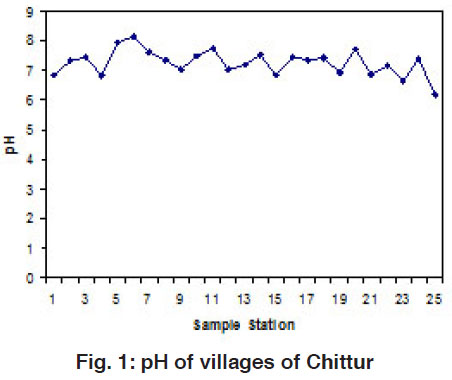 |
Figure 1: pH of villages of Chittur Click here to view figure |
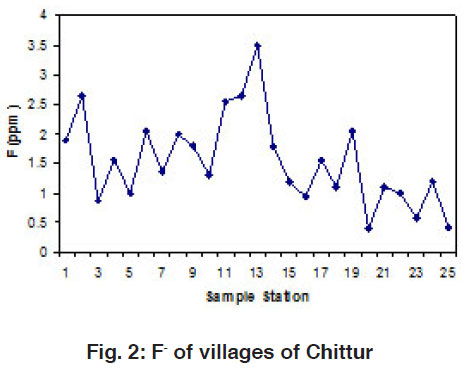 |
Figure 2: F- of villages of Chittur Click here to view figure |
 |
Figure 3: EC of villages of Chittur Click here to view figure |
Materials and Methods
Water samples were collected Prewashed (with detergent, dil.HNO3 and doubly deionized distilled water respectively) in clean polyethylene bottles from bore wells and open wells. The samples were analyzed for different parameters as pH, EC, TDS, Ca, Mg, TH, Cl-, D.O and alkalinity by using standard techniques (APHA-1976).7
Results and Discussion
The results revealed that PH ranged from 6.16 -7.95. Minimum pH (6.16) from sample station-25 and maximum pH (7.95) from sample station -5. PH is expressed as a number ranging from 0-14. The number is an expression of the concentration of H+ ion in the solution. (Table 1, Fig.1). All the samples have PH with in the permissible limit (6.5-8.5). Fluoride (F-) varied from 0.4-2.65 ppm minimum 0.4ppm and maximum 5.44 ppm (Table.1 Fig.2) Permissible limit for F- concentration is 1 -1.5 ppm according to WHO (1996).8 The data revealed that 44% villages of Chittur are affected with high concentration of F- , whereas 20% villages had lower F- concentration. However, 36% villages contained optimum limit of F- concentration (Table - 2)
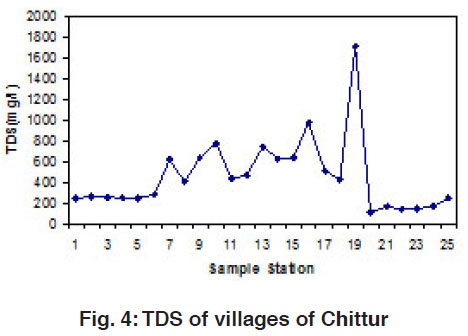 |
Figure 4: TDS of villages of Chittur Click here to view figure |
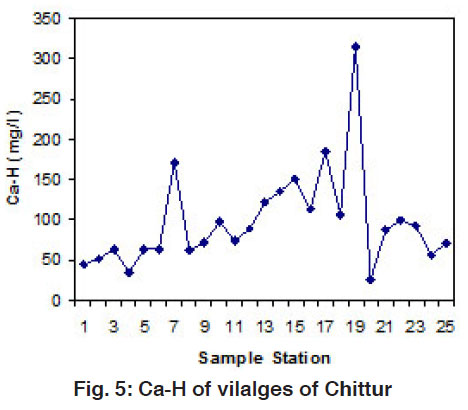 |
Figure 5: Ca-H of vilalges of Chittur Click here to view figure |
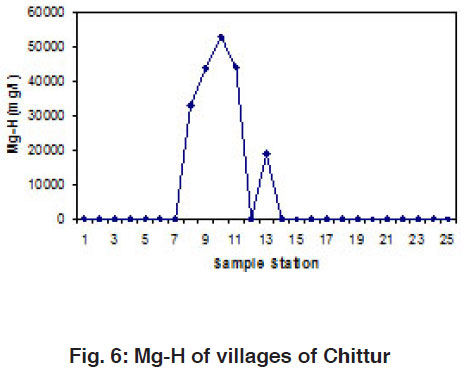 |
Figure 6: Mg-H of villages of Chittur Click here to view figure |
The recommended permissible EC is a numerical expression of ability of an solution to carry electric current limit for electrical conductivity (EC) is 300µmhos/cm. The values of EC ranged from 233.4-3426 µmhos/cm. [minimum 233.4 µmhos/cm and maximum 3426 µmhos/cm]. Only 25% villages, should EC lower than permissible limit (Table.1 Fig. 3). EC signifies the amount of TDS in water. Finding the present study was in agreement with the results of the survey conducted by Gupta etal. (1994).9
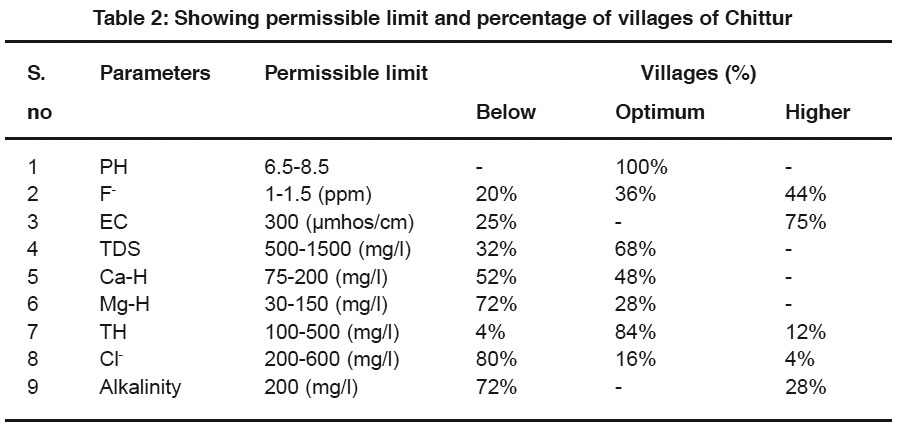 |
Table 2: Showing permissible limit and percentage of villages of Chittur Click here to view table |
 |
Figure 7: TH of villages of Chittur Click here to view figure |
The total dissolved solids (TDS) in drinking water reveal the saline behavior water, which indicates the organic pollution level of water. TDS ranged from 113.6-981.5mg/L. According to WHO (1996)8. TDS should be between 500-1500mg/l (Table.1 Fig.4). TDS was found to be with in limit in 68% villages, lower in 32% villages. (Ca-H) calcium hardness ranged from 26.4 to 313.6mg/L (Table 1 Fig. 5). By the BIS the permissible limit is 75mg/l, so samples are not advisable for drinking. (Mg-H) ranged from 2.92 to 33.21 mg/L (Table 1 Fig.6). Ca-H and Mg- H combined to for total harness. TH varied from 82.6 to 1210mg/L. WHO recommended safe permissible limit for hardness 100-500mg/L. Some bore well samples have hardness above the permissible limit.
 |
Figure 8: Cl- of villages of Chittur Click here to view figure |
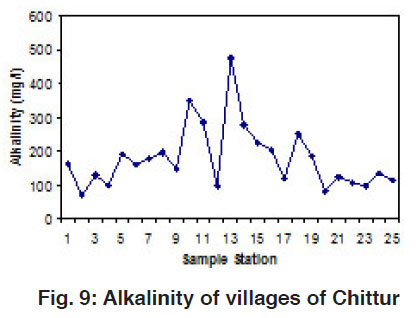 |
Figure 9: Alkalinity of villages of Chittur Click here to view figure |
In ground water hardness is mainly due to CO32-, HCO32-, SO42-, and Cl- of Ca and Mg. Ca-H was within permissible limit in 48% villages where as 52% villages contained Ca-H below than limit. Mg-H was below than limit in 72% villages and 28% Villages showed Mg-H within optimum limit. TH was higher in 12% villages, below than limit in 4% villages where 84% samples contained TH within optimum limit (Table 1 Fig.7), and Chloride (Cl-) varied from 40 – 1265 mg/l. The Cl- content was higher than permissible limit (200 -600mg/l) in 4% villages whereas lower in 80% villages (Table 1 Fig. 8). Only 16% villages were within optimum limit (Table 2). High content of Cl- gives salty taste to water. Alkalinity was higher than permissible limit i.e. (200mg/L) in 28% villages and 72% villages contained alkalinity below than limit (Table- 2). High values of alkalinity give undesirable taste to water. For potable water the dissolved oxygen (DO) should be between 5 to 10 ppm. The concentration of dissolved oxygen might have decreasing due to oxidation of inorganic waste and nutrients and by the process that consume organic matter.
Conclusion
The conclusion, the ground water of palakkad is highly deteriorated as it is polluted with high amount of F- and alkalinity. Most of the parameters were either more than permissible limit or below limit. Therefore the drinking water of villages of Chittur in Palakkad District is not potable. To maintain quality of ground water, the continuous monitoring of physico-chemical parameters should be done and can be used for cooking and drinking only after prior treatment.
References
-
Anonymous, Standard method for examination of water and wastewater (16th Ed.,) American Public Health Association, Washington D.C., (1985) 245-246.
-
Prasad B.G and Narayanan T.S, subsurface water quality of different sampling stations with some selected parameters at Machilipatnam Town. Nat. Env. poll. Tech. (2004) 3(1): 47-50.
-
Anonymous, Report on UN Conf. on Environ. & Development, A/Conf. 151/26., (1992) 1: 277.
-
Singhl S., Mosley L.M., Trace metal levels in drinking water on Viti Levu, Fiji Islands. S. Pac. J. Nat. Sci., (2003) 21: 31-34
-
Sinha.B.P.C. water resources series No.70 ESCAP, (1991) 165-176.
-
Jack G., Prasun.B, and Singh. K.P., SIDA’S Project Report (1999).
-
Anonymous, standard methods for examination of water and waste water (16th Ed.). American public Health Association, APHA, AWWA,WPCF, Washington D.C., U.S.A., (1976).
-
Anonymous., Guidelines for drinking water quality (1996) (2), 231, WHO.
-
Gupta M.K., Singh V., Rajvanni P., Shrivastava S and Dass S., Fluoride in groundwater at Agra. Ind. J. Environ. Health. (1994) 36(1): 43-46.







